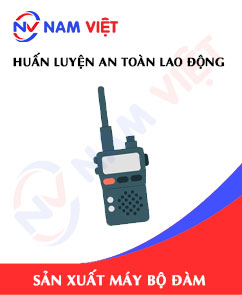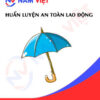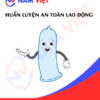Occupational Safety Training in Two-Way Radio Manufacturing
99,000 ₫
Note: The above price is calculated for one person, the price may fluctuate depending on the number of trainees participating in the course and depending on market movements. For more accurate pricing support, please refer to the quotation table or contact our consulting staff directly.
Occupational safety is an important issue in two-way radio manufacturing factories and needs to be addressed promptly to ensure the health and safety of workers, and to enhance the reputation of businesses. The Occupational safety training course is one of the effective solutions to raise awareness about accident prevention for workers participating in two-way radio manufacturing.
Table of Contents
Toggle1. Overview of Two-Way Radios
a. What is a Two-Way Radio?
A two-way radio is a wireless communication device that can be handheld or body-mounted to enable communication between members of a group or between independent individuals.
This device uses radio waves to transmit voice and can operate over long distances depending on the device’s transmission power.
Two-way radios are widely used in various fields such as security, construction, tourism, sports, events, and other industries that require group communication.

b. Machinery Used in Two-Way Radio Production
The machinery involved in the production of two-way radios includes:
- Metal cutting, bending, and stamping machines: used to manufacture metal components of two-way radios such as antenna tubes, front panels, and housings.
- Plastic injection molding machines: used to produce plastic parts of two-way radios such as buttons and protective casings.
- Printing machines: used to print labels and images on the surface of two-way radios.
- Assembly machines: used to assemble the components and electronic parts into a complete two-way radio.
- Testing and diagnostic equipment: used to check the quality of two-way radios before shipment.

c. Two-Way Radio Manufacturers in Vietnam
Famous global two-way radio brands that are widely used include:
- Motorola: one of the largest and most well-known brands worldwide in the two-way radio sector.
- Kenwood: a long-established brand in the two-way radio field, trusted by many users.
- Baofeng: a Chinese brand known for affordable pricing suitable for individual users.
- Icom: provides high-quality two-way radio products for customers worldwide.
- Vertex Standard: established in 1956, supplying high-quality two-way radios to large organizations globally.
- Hytera: a Chinese brand specializing in high-quality two-way radio products.
- Tait Communications: a New Zealand brand providing high-quality two-way radios to large organizations globally.
- Entel: a UK brand specializing in high-quality two-way radio products for large organizations worldwide.
d. Specific Jobs in a Two-Way Radio Manufacturing Factory
Group 1
- Chief Executive Officer, Deputy CEO, department heads in a two-way radio manufacturing factory.
Group 2
- Safety officers: manage safety in the factory, design safety procedures, supervise, and enforce compliance with safe working processes.
Group 3
- PCB Production: Staff assemble electronic circuit boards and check them for quality assurance.
- Housing Fabrication: Materials such as plastic, metal, and rubber are cut, shaped, bent, painted, and assembled to create two-way radio housings.
- Assembly and Quality Control: Staff assemble all parts into complete products and then perform quality checks to ensure standards are met.
- Packing and Shipping: Products are carefully packaged and shipped to distributors or end customers.
- Maintenance and Repair: Some staff are assigned to maintain and repair products if necessary.
Group 4
- Office work, service, sales, and marketing.
- Production management, quality management, human resources management, material management, and financial accounting.
- Design and Research: Electrical and mechanical engineers design and research to develop new products and improve existing ones.

2. Overview of Occupational Safety Training for Two-Way Radio Production
This article focuses on issues related to Group 3 because Group 3 directly participates in production and faces the highest occupational safety risks. Refer to other groups here.
a. What is Group 3 Occupational Safety Training?
- Group 3 Occupational Safety Training provides sessions to equip workers with awareness on preventing workplace accidents.
- The training course helps workers identify and avoid hazards, minimizing risks of accidents during work.
REGISTER FOR OCCUPATIONAL SAFETY TRAINING SERVICE
b. Training Duration
Initial Safety Training Duration
- Total training time is at least 24 hours, including testing time.
- 8 hours of theory on safety policies and labor hygiene laws
- 8 hours of theory on basic knowledge of occupational safety and hygiene
- 4 hours of theory on specialized training content
- 2 hours of practical training on specialized content
- 2 hours of theory test at the end of the course
The training center will arrange the sessions depending on the schedule of workers. Typically, there are 6 training sessions conducted over 3 days, provided the production company can schedule continuous learning time.
Periodic Safety Training Duration
- Before the occupational safety card expires, workers wishing to renew must complete a periodic occupational safety training course, with the periodic training duration at least 50% of the initial training duration.
Explanation: The total periodic occupational safety training duration is at least 12 hours, including testing. Upon completing the course and passing the test, the worker will receive a renewed occupational safety card.
c. Training Course Content
| No. | TRAINING CONTENT | TRAINING DURATION (HOURS) | |||
| Total | Including | ||||
| Theory | Practice | Test | |||
| I | Occupational safety policies and laws | 8 | 8 | 0 | 0 |
| 1 | Overview of the legal documents system regarding occupational safety and hygiene. | 6 | 6 | ||
| 2 | System of standards and technical regulations for occupational safety and hygiene. | 1 | 1 | ||
| 3 | Specific regulations from state management agencies on safety and hygiene when constructing, expanding, or renovating production facilities, and for the use, storage, and inspection of machinery, equipment, materials, and substances with strict safety and hygiene requirements. | 1 | 1 | ||
| II | Basic knowledge of occupational safety and hygiene | 8 | 8 | 0 | 0 |
| 1 | Basic knowledge of hazards and harmful factors in the workplace. | 4 | 4 | ||
| 2 | Methods to improve working conditions. | 1 | 1 | ||
| 3 | Safety culture in production and business. | 1 | 1 | ||
| 4 | Rights and responsibilities of employers and employees; safety and hygiene policies for employees; functions and duties of the safety network. | 1 | 1 | ||
| 5 | Safety and hygiene rules, safety signage, using safety equipment and personal protective equipment; first aid skills, occupational disease prevention. | 1 | 1 | ||
| III | Specialized training content | 6 | 4 | 2 | 0 |
| Comprehensive knowledge of machinery, equipment, substances generating hazardous factors; risk analysis, evaluation, and management; safe working procedures for machinery, equipment, and substances with strict safety and hygiene requirements. | 6 | 4 | 2 | ||
| IV | Final assessment of safety training content | 2 | 2 | 0 | 0 |
| Total | 24 | 22 | 2 | ||
See more training content of the 6 groups
d. Occupational Safety Card
After completing the occupational safety training and passing the test, the worker will be issued an Occupational Safety Card (commonly called Occupational Safety Certificate for Group 3).
The Group 3 safety card displays information such as full name, date of birth, specific job and work environment, as well as training duration, red stamp, and signature confirming completion.
According to regulations on issuing safety cards stated in Clause 2 of Article 24 of Decree 44/2016/ND-CP, there are two cases:
- If the employer and employee have a labor contract, the employer must sign and stamp the safety card for the Group 3 worker after completing training at an occupational safety training unit and passing the test.
- If the worker is freelance or seasonal and does not have a labor contract, the training unit must sign and stamp the safety card after the worker completes the training and passes the test.

3. Identifying Hazards Affecting Workers in Two-Way Radio Manufacturing
Some hazards that may affect workers in two-way radio manufacturing include:
- Risk of impact: Assembly, transportation, and maintenance machinery for two-way radios may pose impact risks to workers, especially when personal protective equipment such as helmets, safety shoes, and protective gloves and footwear are not worn.
- Risk of electric shock: During manufacturing, the electronic components of two-way radios may pose a risk of electric shock to workers without experience and knowledge of electricity.
- Risk of chemical poisoning: Chemicals may be used for cleaning or preserving parts of two-way radios during manufacturing, posing a risk of chemical exposure to workers.
- Risk of getting lost or injured: While working in a two-way radio factory, workers may get lost or injured for various reasons, including unsafe environmental conditions and lack of proper protective measures.
- Risk of occupational accidents: Machinery and equipment used in two-way radio manufacturing can cause occupational accidents, especially when not used correctly or safely.
- Risk of back pain: Tasks that require workers to stand or sit for long periods may cause back pain if not performed correctly or without adequate health protection measures.
4. Common Occupational Accidents for Workers in Two-Way Radio Manufacturing
Common occupational accidents in two-way radio manufacturing may include:
- Electrical accidents: due to faulty or unsafe electronic components during assembly or use, leading to electric shock or fire hazards.
- Chemical accidents: chemicals used for cleaning, processing, or manufacturing components may cause burns or toxic exposure if not handled safely.
- Mechanical accidents: during assembly, repair, or maintenance, machinery such as cutters or grinders may cause accidents if not used properly or safely.
- Physical accidents: transporting or moving equipment or manufacturing materials may lead to collisions, falls, or impacts.
- Natural hazard accidents: if two-way radios are manufactured outdoors, natural hazards such as lightning, storms, or tornadoes may pose risks to workers.
5. Safety Measures for Participating in Two-Way Radio Manufacturing
Safety measures for participating in two-way radio manufacturing include:
- Providing personal protective equipment: Ensure workers use full personal protective equipment such as helmets, safety glasses, gloves, respirators, etc.
- Occupational Safety Training: Workers need to be trained on occupational safety knowledge, machinery operation skills, and manufacturing procedures.
- Using safe machinery: Machines must be designed and manufactured to ensure safety and prevent technical faults that could endanger users.
- Regular inspection, maintenance, and repair of machinery: Ensure machines remain in good working condition to minimize the risk of accidents.
- Following correct manufacturing procedures: Workers must follow proper manufacturing procedures without exceeding machine limits.
- Quality control of products: Ensure products meet technical and quality requirements to avoid hazards for users.
- Organized and classified materials: Prevent scattered tools or materials that could pose risks to workers.
- Implementing fire prevention measures: Ensure firefighting equipment is always ready and fire safety measures are implemented effectively.
- Regular workplace environmental monitoring in factories to collect and analyze harmful factors for workers, adjusting and reducing hazards to prevent occupational diseases.

6. Benefits of Occupational Safety Training in Two-Way Radio Manufacturing
An Toan Nam Viet provides your business with the following benefits upon completing occupational safety training courses according to Decree 44/2016/NĐ – CP regarding occupational safety and hygiene for companies, factories, and enterprises:
- Workers can identify potential occupational hazards and take preventive measures to avoid accidents.
- Your enterprise can establish risk prevention measures in manufacturing, operation, and maintenance processes.
- Reduce costs associated with potential workplace safety risks.
- Uninterrupted manufacturing processes improve labor productivity and product quality.
- Comply with occupational safety laws, avoiding legal risks.
- Enhance reputation and professionalism, thereby elevating your business brand.
An Toan Nam Viet’s training courses are a solution to prevent external hazards from affecting individuals, helping them avoid dangers that could lead to injuries or, in severe cases, death.
REGISTER FOR OCCUPATIONAL SAFETY TRAINING SERVICE
7. Customer Feedback After Completing Two-Way Radio Manufacturing Safety Training
An Toan Nam Viet has many years of experience in accompanying businesses across Vietnam, especially in southern provinces. This responsibility is extremely valuable, which is why An Toan Nam Viet’s Occupational Safety Training is increasingly professional. The growth and development of An Toan Nam Viet are fueled by positive feedback and suggestions from businesses. Below are testimonials from partners we have served.
Bac Nam E&C Investment and Construction Joint Stock Company
“The first time I used the service at An Toan Nam Viet, I was very surprised by the enthusiastic 24/7 support from the consulting team. The class organization was quick and convenient for our company. Thank you very much, An Toan Nam Viet!”
Hoa Dat Construction and Trading Joint Stock Company
“An Toan Nam Viet’s service has greatly helped us simplify occupational safety and complete safety documentation for work processes. The consulting team is enthusiastic and timely in addressing our questions. Five stars for An Toan Nam Viet.”
See more customer interview sessions after using the service of An Toan Nam Viet
8. Occupational Safety Training Capability of An Toan Nam Viet
An Toan Nam Viet is a reputable and quality center for occupational safety training in Vietnam today. Training sessions are continuously conducted at manufacturing factories, workshops, or construction sites across the country (all 63 provinces in Vietnam).
REGISTER FOR OCCUPATIONAL SAFETY TRAINING SERVICE
Occupational safety training license
- An Toan Nam Viet has been inspected and granted a certificate of eligibility for occupational safety and hygiene training by the Department of Occupational Safety under the Ministry of Labor – Invalids and Social Affairs. This further solidifies our capability in occupational safety training.

Training materials and lectures
- Before the occupational safety training materials are used in safety training courses, they are reviewed to ensure accurate knowledge and effective application.
- Teaching methods are standardized according to An Toan Nam Viet’s approach, developed by experts in occupational safety and hygiene training to maximize knowledge absorption for learners.
Facilities
- Controlling classroom factors affecting training increases teaching efficiency and knowledge retention.
- Our training support facilities provide spacious classrooms meeting standards for area, lighting, and training equipment.
9. Nationwide Reputable and Quality Safety Training Center
At An Toan Nam Viet, we prioritize professional dedication in occupational safety training. We aim to equip workers with self-protection knowledge for a safe livelihood, contributing to national development.
To ensure effective training, we meticulously prepare every detail—from tools, teaching equipment, curriculum, materials, to sound and lighting systems.
Our occupational safety trainers are experts with extensive experience, including research on hazard identification in various industries and methods to prevent them.
Lectures are based on practical experience and conveyed in a vivid, easy-to-understand manner for workers, ensuring comfort during learning and effective knowledge absorption. Training content strictly follows Decree 44/2016/NĐ-CP.
This helps workers understand multiple preventive measures and how to protect themselves, applying them appropriately in real work situations.
Our training center proudly provides professional and reputable occupational safety training services with the following advantages:
- Competitive training costs while ensuring quality.
- Flexible training schedules aligned with the company’s manufacturing operations.
- Quick certification procedures compliant with legal regulations.
- Trainers with many years of experience.
- Classrooms optimized for teaching efficiency and learner knowledge retention.
- Lectures designed to fit occupational safety needs in enterprises.
- An Toan Nam Viet works diligently and professionally to provide accurate and prompt customer support.

10. Additional References for Occupational Safety Training in Two-Way Radio Manufacturing
- Two-Way Radio Manufacturing Occupational Safety Documents
- Occupational Safety Training Materials Set
- Occupational Safety Training Test Set
- Occupational Safety Training Curriculum for Two-Way Radio Manufacturing
- Two-Way Radio Manufacturing Occupational Safety Quiz
1 review for Occupational Safety Training in Two-Way Radio Manufacturing
No comments yet















namchinh.haiphong341
Dịch vụ huấn luyện an toàn lao động rất tốt nhé!